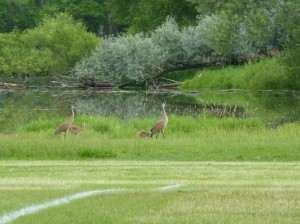Marlene Hardick reports that the cranes are back in North Madison:
Sandhill cranes were heard in Cherokee Marsh on the morning of Friday, Feb. 25. This marsh stretches along Wheeler Rd on the north side of Madison, Wisconsin. They are arriving from their winter home in Florida. They will now begin mating and will be easy to hear and see around the Marsh. They will remain with us until late November.
A friendly pair of cranes (Shown here last year)

has lived in Warner Park for many years and have raised many chicks. They are often seen outside the windows of Warner Park Community Recreation Center, where they consider the seniors and manager Brad Weisinger to be special friends. (Ask Brad to see his photo album.)
The sandhill crane is a tall gray bird with a wingspan of 6-7 feet. Adults have yellow eyes, black bills, legs and feet, with a bright red patch on the crest of their head. Males and females look nearly alike.
When they are 3-7 years old, cranes select a mate and may remain with that mate for 30 years. Their noisy mating dance and calls can often be heard two miles away in the spring. They lay 1-2 eggs in a nest on the ground. The nest is a heap of grass, spreading five feet across, high enough so water won’t seep thruough, -and built near water. Both parents incubate the eggs for 30 days, then raise the chicks together. Chicks begin to fly in July and are ready to migrate with parents by November.
Cranes feed on tubers, worms, grasshoppers, snails, frogs, seeds, eggs of other birds and sometimes snakes, small birds and mice.
North America has two crane species–sandhill cranes and whooping cranes, a large white bird. There are six sub-species of sandhill cranes. There are 15 species of cranes in the world. Eleven of them are endangered. The sandhill crane was near extinction in the 1800s, but has made a dramatic comeback.
You must be logged in to post a comment.